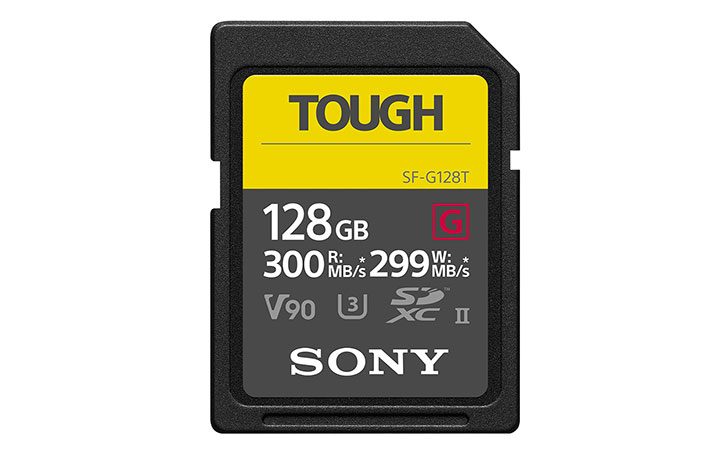Sony today announced a brand new innovation in storage media with the launch of the “SF-G series TOUGH specification”UHS-II SD card. Addressing the needs of photographers who are reliant upon their photographs remaining safe when their SD cards are removed from the camera, the new SF-G series TOUGH specificationrange combines the world’s fastest read and write speeds with an ultra-rugged design that is bend proof to 180N, and drop proof to 5 metres. For photographers who are fighting against the elements to get the perfect shot, the SF-G series TOUGH specification range of SD cards are also waterproof with an IPX8 rating and dustproof with an IP6X rating.
The new SF-G series TOUGHspecification range of SD cards are 18 times stronger than the SD standard[ix] with world’s first monolithic structure (one-piece molding, no empty space in the card) and materials of high-grade hardness, unlike conventional SD cards with a thin, 3-part ensemble. They areprotected against typical physical damage that can affect conventional SD cards such as a broken plastic casing, broken data protection lock and broken connector ribs. This has been achieved through a new means that it is the world’s first rib-less SD card with no write protection switch. These developments ensure that the SF-G series TOUGH specificationis more resistant to bending and easy to break parts are removed entirely and has been engineered by Sony to deliver the best balance of hardness and toughness. Completely sealed with one-piece molding structure, no waterdrop, dust or dirt is not allowed to come into the card, meeting highest grade of waterproof (IPX8) and dustproof(IP6X).
Unleash the power of the camera
In an industry trend, driven by Sony, full-frame mirrorless cameras such as the α9 and α7 series are packing in more and more performance in both stills and video performance. These high-end cameras rely on fast memory cards to maximise their performance and with professional photographers now using SD cards more frequently, users are demanding the levels of reliability and durability associated with other professional card types. With the world’s fastest write speed of up to 299MB/s, buffer clearing time is minimised. This allows the photographer to shoot many frames per second and capture the action that they want. The SF-G series TOUGH specification range also supports V90, the highest standard of video speed class, making it an ideal companion for shooting high resolution video.
Furthermore, transferring high capacity photo and video files is made simple with the SF-G series TOUGH specification, thanks to a read speed of up to 300MB/s. This is another world’s fastest which dramatically enhances workflow efficiency after the shooting is all wrapped up. In a further acknowledgement of the practical needs of photographers, the SF-G series TOUGH specification range feature bright yellow banding design, making the card easier to spot in dark shooting conditions.
Ultimate Assurance
SF-G series TOUGHspecification SD cards offer a series of further features, designed to give photographers peace of mind. These include an ‘SD Scan Utility’ which allows the user to check that the card is good condition and File Rescue Software[x] which can recover data and photos that might have accidentally been deleted. Furthermore, SF-G series TOUGH specification SD cards are also X-ray proof, magnet proof, anti-static, temperature proof and feature UV Guard.
Pricing and Availability
The SF-G TOUGH series of memory cards will be available in 32GB, 64GB and 128GB capacities. They will launch in Europe from October. Full product details are available at: http://www.sony.net/sfgt/


And I also miss the data protection lock.
I can't agree, I say good riddance. Every SD card "failure" I've ever had was due to this switch becoming loose and automatically locking the card every time I inserted into the card slot. With UHS-I and older cards you can sort of get around it by taping over the switch. However, with UHS-II cards the extra row of pins means that there's no longer enough surface on the pin side of the card near the switch for the tape to hold onto so the tape rolls up when you try inserting it into the slot.
I suggest that you follow the provided link to the sony site and watch the video for the test. Its pretty clear how its done, and you can avoid looking foolish.
I'll even make it easier. Scroll down to the Bending Resistance Test Video!
https://www.sony.net/Products/memorycard/en_us/toughcard/
I' ve been using exclusively UHS-1 card, and never had an issue. Sorry you had trouble with UHS-2, so "lockless" seems to be an advantage!
It would make sense to me that the specs would flow from engineering to marketing, not the other way around.
FWIW, most people don't know what a mega pixel is or means either. They just care that the # is higher the next time they buy. Sounds impressive even if they have no idea what it means. Same with "Bend proof to 180N". For all I know a standard card is bend proof to 179N. I actually never knew there was such a torture test until now, but from now on I will be checking that # in all future card marketing literature. Well, not really. But that is what the marketing people hope for.
If a standard card survives a 179N test force then 180N isn't much to brag about. Question is, what is the load case and resulting bending moment? A Nm (or Nmm or whatever unit is appropriate) rating would actually say something.
It's like when our marketing department bragged about our products being tested for in excess of 200.000 opening cycles, nevermind that number being chosen to ensure the standard requirements of products surviving 100.000 openings taking into account the small number of products actually tested.